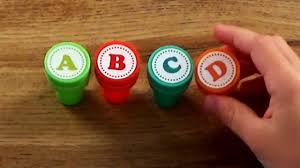Young children will find Alphabet stamps to be an entertaining and instructive tool. They help children acquire critical skills and make learning fascinating. Children may investigate language, hone motor abilities, and learn attention by stamping letters. Children who participate in hands-on learning remain interested and are helped to grow playfully. Let’s look at how the daily use of alphabet stamps benefits children.
Developing Coordinating and Fine Motor Skills
The way alphabet letter stamps support the development of fine motor skills is among its main advantages. Fine motor abilities are those involving the fingers’ and hands’ tiny muscles. Children need these muscles for cutting, writing, and drawing as well as for other tasks. Pressing a stamp in ink, then laying it on paper calls for control and synchronization.
Every action teaches children proper object grasp. It works their wrists and fingers. Picking up and utilizing stamps repeatedly enhances hand-eye coordination. Studies reveal that practical exercises like stamping enable kids to improve their movement control.
Youngsters also pick up spatial awareness. They know the space each letter takes on paper. This helps them to write orderly going forward. The more stamps they apply, the more self-assured they grow in handling learning activities with their hands.
Promoting Literary and Language Development
Excellent resources for learning a language are alphabet stamps. As they stamp, young children may see, touch, and use the letters. This multimodal method facilitates their memory of letter forms and sounds more readily. It also clarifies for them the distinctions between uppercase and lowercase letters.
Children may stamp out their names, simple words, and even full sentences. This approach develops early spelling and reading abilities. When they arrange stamps to form words, toddlers grasp how letters interact to produce meaning. Their vocabulary grows more broadly the more they experiment.
Alphabet stamps let parents and teachers assist in storytelling projects. Children help children link letters to concepts by stamping essential words from a story. This helps them to understand better and motivates original expression. Studies reveal that for young learners, combining creative activities with literacy teachings increases interest and memory.
Emphasizing organization, patience, and focus
Using alphabet stamps for instruction goes beyond simply letter learning. It also guides children toward patience and concentration. Every time a young child chooses a stamp dips it in ink and gently presses it on paper, they are developing their concentration. They must remain concentrated to apply the right stamp and align it correctly.
Children who follow this technique learn patience and should pay great care. They pick up slowing down, considering their actions, and timing to get the optimum results. They grow increasingly sure with a time of following directions and finishing projects on their own.
Alphabet stamps also support structure. Once used, children can sort and arrange their stamps. They might arrange them either alphabetically or by size. Stamp storage and cleaning foster responsibility. Children who follow simple routines like this grow in good habits and order.
Including Fun into Regular Education Programs
Every day, alphabet letter stamps find several inventive applications. Parents and teachers can create exercises including favorite objects, sight words, or stamping names. Children get more at ease with letters the more stamps they use.
Great for group projects are alphabet stamps as well. Youngsters can team on stamping projects. They can alternately share supplies, help one another spell words, and take turns. This increases social skills and collaboration. Children pick up communication, teamwork, and respect for one another as well as fun.
Teachers of different languages sometimes utilize alphabet stamps. Children pick up many languages and cultures by using stamps bearing letters from many alphabets. This stimulates interest and helps them to see the world differently.
